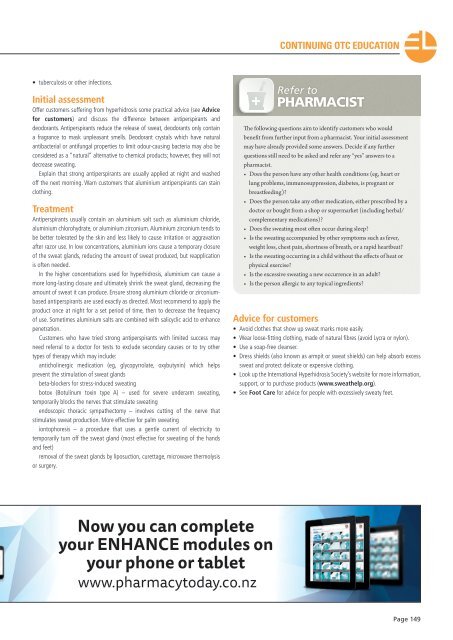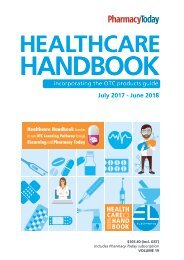2017 HCHB_digital
Create successful ePaper yourself
Turn your PDF publications into a flip-book with our unique Google optimized e-Paper software.
CONTINUING OTC EDUCATION<br />
• tuberculosis or other infections.<br />
Initial assessment<br />
Offer customers suffering from hyperhidrosis some practical advice (see Advice<br />
for customers) and discuss the difference between antiperspirants and<br />
deodorants. Antiperspirants reduce the release of sweat, deodorants only contain<br />
a fragrance to mask unpleasant smells. Deodorant crystals which have natural<br />
antibacterial or antifungal properties to limit odour-causing bacteria may also be<br />
considered as a “natural” alternative to chemical products; however, they will not<br />
decrease sweating.<br />
Explain that strong antiperspirants are usually applied at night and washed<br />
off the next morning. Warn customers that aluminium antiperspirants can stain<br />
clothing.<br />
Treatment<br />
Antiperspirants usually contain an aluminium salt such as aluminium chloride,<br />
aluminium chlorohydrate, or aluminium zirconium. Aluminium zirconium tends to<br />
be better tolerated by the skin and less likely to cause irritation or aggravation<br />
after razor use. In low concentrations, aluminium ions cause a temporary closure<br />
of the sweat glands, reducing the amount of sweat produced, but reapplication<br />
is often needed.<br />
In the higher concentrations used for hyperhidrosis, aluminium can cause a<br />
more long-lasting closure and ultimately shrink the sweat gland, decreasing the<br />
amount of sweat it can produce. Ensure strong aluminium chloride or zirconiumbased<br />
antiperspirants are used exactly as directed. Most recommend to apply the<br />
product once at night for a set period of time, then to decrease the frequency<br />
of use. Sometimes aluminium salts are combined with salicyclic acid to enhance<br />
penetration.<br />
Customers who have tried strong antiperspirants with limited success may<br />
need referral to a doctor for tests to exclude secondary causes or to try other<br />
types of therapy which may include:<br />
anticholinergic medication (eg, glycopyrrolate, oxybutynin) which helps<br />
prevent the stimulation of sweat glands<br />
beta-blockers for stress-induced sweating<br />
botox (Botulinum toxin type A) – used for severe underarm sweating,<br />
temporarily blocks the nerves that stimulate sweating<br />
endoscopic thoracic sympathectomy – involves cutting of the nerve that<br />
stimulates sweat production. More effective for palm sweating<br />
iontophoresis – a procedure that uses a gentle current of electricity to<br />
temporarily turn off the sweat gland (most effective for sweating of the hands<br />
and feet)<br />
removal of the sweat glands by liposuction, curettage, microwave thermolysis<br />
or surgery.<br />
Refer to<br />
PHARMACIST<br />
The following questions aim to identify customers who would<br />
benefit from further input from a pharmacist. Your initial assessment<br />
may have already provided some answers. Decide if any further<br />
questions still need to be asked and refer any “yes” answers to a<br />
pharmacist.<br />
• Does the person have any other health conditions (eg, heart or<br />
lung problems, immunosuppression, diabetes, is pregnant or<br />
breastfeeding)?<br />
• Does the person take any other medication, either prescribed by a<br />
doctor or bought from a shop or supermarket (including herbal/<br />
complementary medications)?<br />
• Does the sweating most often occur during sleep?<br />
• Is the sweating accompanied by other symptoms such as fever,<br />
weight loss, chest pain, shortness of breath, or a rapid heartbeat?<br />
• Is the sweating occurring in a child without the effects of heat or<br />
physical exercise?<br />
• Is the excessive sweating a new occurrence in an adult?<br />
• Is the person allergic to any topical ingredients?<br />
Advice for customers<br />
• Avoid clothes that show up sweat marks more easily.<br />
• Wear loose-fitting clothing, made of natural fibres (avoid Lycra or nylon).<br />
• Use a soap-free cleanser.<br />
• Dress shields (also known as armpit or sweat shields) can help absorb excess<br />
sweat and protect delicate or expensive clothing.<br />
• Look up the International Hyperhidrosis Society’s website for more information,<br />
support, or to purchase products (www.sweathelp.org).<br />
• See Foot Care for advice for people with excessively sweaty feet.<br />
Now you can complete<br />
your ENHANCE modules on<br />
your phone or tablet<br />
www.pharmacytoday.co.nz<br />
Page 149



